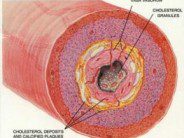Peripheral artery disease (PAD) is a vascular disease that results in obstruction of large arteries in the peripheral vasculature that do not include the coronary arteries, cerebral arteries, or aortic arch. PAD results from the same risk factors that influence the development of other atherosclerotic diseases. These risk factors include high blood pressure, diabetes, high cholesterol, smoking, and a family history of early heart disease. A diagnosis of atherosclerotic disease in one region of the body suggests that there could also be PAD. Patients with coronary artery disease or cerebrovascular disease have higher likelihoods of also having PAD. Researchers lead by Dr. John Cooke have recently provided evidence that a sedentary lifestyle or low lifetime recreational activity is a risk factor for the development of PAD. The results of their research were published online in the Journal of Vascular Surgery. The researchers studied 1,381 patients who had been referred for coronary angiography. PAD was defined as an ankle-brachial index (ABI) of less than 0.9 at the time of the study or having a history of revascularization of the lower extremities. The researchers used a questionnaire to retrospectively assess the lifetime recreational activity of the study participants. Statistical analyses were used to determine the association of lifetime recreational activity to ABI and the occurrence of PAD. The researchers found that PAD was found in 19% of the study participants. The study participants who had no regular lifetime recreational activity had greater diastolic blood pressure, had lower average ABI, were more likely to be female, and had a higher likelihood of developing PAD. Using statistical analyses, the researchers found that lifetime recreational activity was a positive predictor of PAD, and a history of sedentary lifestyle independently increases the risk of developing PAD. The authors wrote, “Low levels of [lifetime recreational activity] were associated with low ABI and with the diagnosis of PAD, independently of traditional risk factors, in patients undergoing cardiac catheterization. Subjects in the least active group were more likely to be female and had higher diastolic blood pressure. The risk of PAD was increased by 1.5-fold in those with no history of recreational activity, corrected for other cardiovascular disease risk factors. Strategies to increase recreational activity may reduce the burden of PAD later in life. For health care providers, a history of no lifetime recreational activity may heighten the clinical index of suspicion for PAD”. This study adds to the already known benefits of a routine physical activity program coupled with a heart healthy diet.
Listen to the Medpage Today interview with Dr. John Cooke below:
Reference:
Andrew M. Wilson et al. “Low lifetime recreational activity is a risk factor for peripheral artery disease” Journal of Vascular Surgery Volume 54, Issue 2, pp 427-432










 DrSamGirgis.com is a blog about medicine, nutrition, health, wellness, and breaking medical news. At DrSamGirgis.com, the goal is to provide a forum for discussion on health and wellness topics and to provide the latest medical research findings and breaking medical news commentary.
DrSamGirgis.com is a blog about medicine, nutrition, health, wellness, and breaking medical news. At DrSamGirgis.com, the goal is to provide a forum for discussion on health and wellness topics and to provide the latest medical research findings and breaking medical news commentary.
{ 0 comments… add one now }